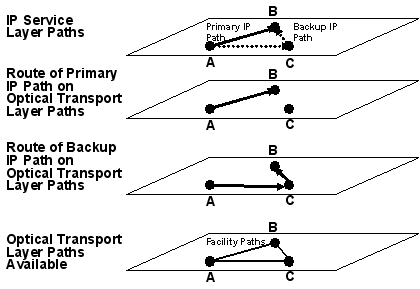
article page
| 1
| 2
| 3
transport gear, cable, etc. and that the protection path is fully diverse from the main path.
Figure 1 shows an example of this. The IP layer has a main path and a backup path, but in this case both the main and backup paths are routed on the same transport facility - not a good situation, but one that is very difficult to avoid without a deep knowledge of the current and planned network topology.
Proper diversity planning also requires the ability to determine if diversity exists among network layers – with IP/MPLS on top of ASON being an example, as shown in Figure 2. However, diversity can be engineered into the network at many different layers.
|
|
New service adoption rates and demographics are often unknown, even with market trials, as early results often are applicable only to early technology adopters. |
|


service – especially a bandwidth-hungry video service – is marketed, network architecture must be adjusted by geography and timing to match the network capacity of bandwidth, signaling, transaction processing and information storage. Failure to do so can lead to under-resourcing and low QoS – death to new service adoption – or over-consumption of precious capital. This has driven leading carriers to move from yearly to quarterly
|
|
|

Figure 2: An example of a correct backup diversity plan
|
|

So what is the best strategy? Should diversity be engineered in at the highest level only, e.g. at the IP layer (ensuring, of course, that paths are diverse in the underlying transport network)? Or just at the lowest layer of the transport network? Or a combination of the two? And how should that diversity be maintained as the network evolves and additional layered capacity is added? These issues are at the leading edge of modern Integrated Network Planning systems.
Re-Planning to Match Service Adoption Characteristics
New service adoption rates and demographics are often unknown, even with market trials, as early results often are applicable only to early technology adopters. Thus, as a new
|
|

planning cycles – with an ultimate goal of monthly or twice-monthly planning, in a move toward "just in time" network capacity augmentation. Good Integrated Network Planning systems do this planning quickly, enabling these short planning cycles.
Integrated Network Planning Systems and New Services
Modern Integrated Network Planning systems meet the three main challenges of planning for new services head on, quickly providing comprehensive, holistic, robust network designs and, as a result, allowing the network to be planned – and re-planned – to match the requirements of the new services, while optimizing precious capital resources.
article page
| 1
| 2
| 3
| |
|




